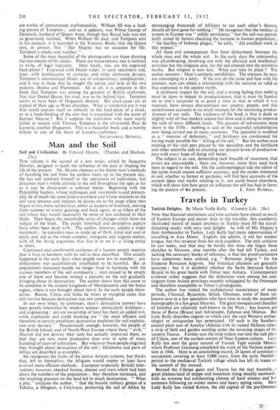Man and the Soil
Tuns volume is the second of a new series, edited by Jacquetta Hawkes, designed to teach the influence of the past in shaping the life of the present. Mr. Hyams chooses as his theme man's methods of handling the soil from the earliest times up to the present day. He has not confined himself to the operations of cultivation, but discusses man's whole attitude to the soil throughout the ages as far as it can be discovered—a colossal theme. Beginning with the Paleolithic hunters, whose techniques and view points would presum- ably be of much the same kind everywhere and whose relations to the soil were tenuous and indirect, he passes on to the stage where men began to live more settled lives, either as keepers of livestock, moving from summer to winter grazings and back again, or as tillers of the soil where they would necessarily be more or less anchored to their fields. Then began the remarkable series of changes which form the subject of the book. The purely historical and descriptive aspects have often been dealt with. The author, however, adopts a wider treatment ; he considers man as made up of flesh, mind and soul or spirit, and soil as the whole complex, inorganic and organic matter, with all the living organisms that live in or on it—a living entity in short.
Continued and comfortable existence of a human society requires that it lives in harmony with its soil as here described. This usually happened in the early days when people were few in number ; any disharmony was quantitatively insufficient to be harmful. But as populations increased people no longer lived in harmony with the various members of the soil community ; man ceased to be simply one of them and became instead a parasite on the soil gradually bringing about its destruction. The author shows how this came to be complete in the ancient kingdoms of Mesopotamia and the Indus region, where it was brought about slowly by the early people them- selves. Russia, China and India he treats as marginal cases that still survive because destruction was not completed.
In our own times, he continues, man's destructive powers have been greatly intensified by modern science—particularly fertilisers— and engineering ; private ownership of land has been an added evil, while capitalism and credit banking are " the most efficient and therefore in certain conditions destructive machines for soil exploita- tion ever devised." Paradoxically enough, however, the people of the British Islands and of North-West Europe where these " evils " flourish did not destroy their soils but actually improved them, so that they are now more productive than ever in spite of many hundreds of years of cultivation. But wherever these people migrated they brought about destruction of the soil ; Oklahoma and parts of Africa are described as examples.
He recognises the faults of the native African systems, but thinks that, left to themselves, the Africans would sogner or later have evolved more efficient methods. European (especially British) inter- vention, however, checked famine, disease and wars which had kept down the numbers of the population ; they therefore increased, and the resulting pressure on the land led to much destruction. " What a pity," exclaims the author, " that the bucolic military genius of a Tchaka, a Dingaan, a Cetywayo, protecting the soil of Africa by encouraging thousands of Africans to cut each other's throats, should all have gone for nothing ! " He recognises that the mediaeval system in Europe was " mildly pernicious," but the soil was period- ically rested by factors checking the increase in human population ; " the bacillus of bubonic plague," he adds, " did excellent work in this respect."
All these evil consequences flow from disharmony between the whole man and the whole soil. In the early days the relationship was all-embracing, involving not only the physical and intellectual activities but the religious also, for the soil entered into the primitive myths. But religion is now lost. What can take its place ? The author answers : Man's aesthetic sensibilities. The sciences, he says, are converging to a unity. If the arts do the same and fuse with the sciences, man can attain a relationship with the universe as valid as that expressed in the ancient myths.
A profound respect for the soil, and a strong feeling that nothing must be done to impair its productiveness, that it must be handed on to one's successor in as good a state as that in which it was received, have always characterised our country people, and this sensitiveness accounts in no small measure for the increasing produc- tiveness of our soils. The weakness of the book is that it deals so slightly with all that modern science has done and is doing to improve the soils of many different lands. The account of soil-erosion stops short in the 1930s : nothing is said of the successful rehabilitation now being carried out in many countries. The specialist is snubbed as a__" monster of deformity," and fertilisers are condemned for having made possible the " killing of the soil." But the author says nothing of the vital part played by the specialists and the fertilisers and other scientific aids in attaining our present levels of productive-. ness with every hope of doing still better.
The subject is so vast, demanding such breadth of treatment, that errors are unavoidable ; there are, however, more than need have been in regard to the soil. On the anthropological side the editor of the series would ensure sufficient accuracy, and the reader interested in soil, whether as farmer or gardener, will find here accounts of the ancient ideas and myths relating to it, not easily found elsewhere, which will show him how great an influence the soil has had in form-


























 Previous page
Previous page